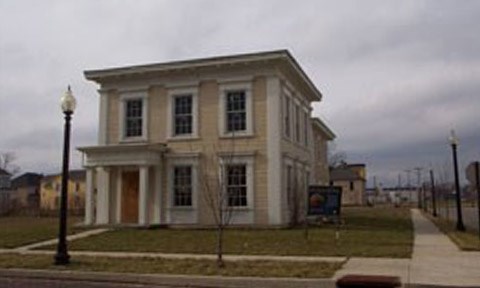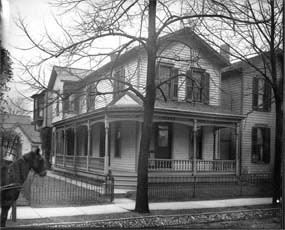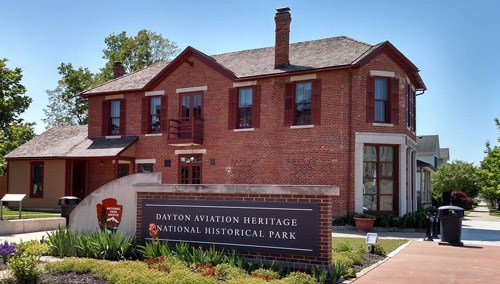|
Best known as the home of Orville and Wilbur Wright, the Wright-Dunbar Village developed as a Dayton streetcar suburb in the half century following the Civil War, and it was annexed to the city of Dayton in 1869. The area includes a residential neighborhood and the Wright Dunbar Business Village, also known as the West Third Street Historic District. The name “Wright-Dunbar Village” is modern, and Paul Laurence Dunbar never lived in the neighborhood himself.
In the late 1890s, Wright-Dunbar became home to a diverse urban population, including Hungarians, Romanians and Eastern Europeans of the West Side Colony. These workers came to work in Dayton factories and formed a tight community with a host of businesses, churches, and social organizations to meet their needs. Connected to the rest of the city by five streetcar lines, it attracted increasing numbers of middle-class residents who left the old city center to reside on the west side of the Great Miami River.
In the years following World War I, the area emerged as the cultural and commercial center of Dayton's African American community. Black-owned businesses such as the Palace Theater helped build a strong African American community. The population shifted in this area in the years after the war and there was a widespread movement of African Americans from the South to the “Industrial North” as part of the Great Migration. Housing segregation also forced many African American residents to live in West Dayton.
The destruction of residences and businesses resulting from the construction of Interstate 75 in the early 1960s, and later by U.S. Route 35, had a devastating effect on many neighborhoods but most notably on the West Dayton commercial district. The face and character of the area changed even more drastically on September 1, 1966, when racial disturbances broke out in the commercial district. These events further contributed to a pattern of disinvestment in the neighborhood. Although a large portion of the area was lost in the 1950s and 1960s to interstate construction, urban renewal, and civil unrest, the remaining historic structures in Wright-Dunbar Village are experiencing a period of revitalization. A large amount of the work began with the launch of an effort to rebuild a West Dayton neighborhood that had once been home to the Wright brothers. Innovative housing strategies by the city of Dayton, combined with Dayton Aviation Heritage National Historical Park and the work of Wright-Dunbar, Inc. have assisted in creating a viable urban neighborhood and a resource for Dayton history. 
NPS Photo Residential InformationThe oldest house in the neighborhood is the Fitch House, constructed in the 185s (at what is now the corner of South Williams Street and Fourth Street). It was owned by Daniel and Sarah Fitch and was home to them and their five children. Daniel Fitch was associated with publishing the Western Empire newspaper from 1848 - 1870. The home remained in the Fitch family until 1925. 
Wright State University Special Collections and Archives One of the few brick homes in the neighborhood is located at 30 South Williams Street. Constructed post-1869, it was owned by Frank Hamburger, who owned and operated a hardware store along West Third Street. Rehabilitated by the city of Dayton, the home is now the location of the administrative offices of Dayton Aviation Heritage National Historical Park. The Queen Anne style house located at 803 West Fifth Street was the residence of Captain Robert H. Mallory, known for his relentless efforts on behalf of Dayton’s African American community. Following his military service as a captain in World War I, Mallory served as executive director of the Linden Community Center for seventeen years, devoting his life to furthering the interests and quality of life of Dayton’s Black community. Among the residential homes, are some commercial structures. The building at 907-915 West Fifth Street was home to one of the oldest Black YMCAs in the country. Through the efforts of several leaders in the community, including Captain Robert Mallory, Edward T. Banks, and Dr. Lloyd Cox, this facility opened on New Year’s Day, 1928. In 1978, the YMCA relocated to a new facility on Dayton-Liberty Road. The building was rehabilitated in the 1990s, and it is currently the location of the Dayton Urban League. 
NPS Photo / Ryan Qualls Commercial District InformationThe commercial district is comprised of two- and three-story brick buildings built between 1885 and 1924. As is typical of turn-of-the-century commercial districts, most of the buildings originally had stores on the ground level with offices and residences above. The style of the buildings is predominately Romanesque Revival, with several examples of Italianate and Classical Revival buildings enlivening the mix. Located along the edge of the commercial district, the brick building at 22 South Williams Street was constructed by two brothers, Abraham and Joseph Nicholas, in 1886. In 1895 the Wright brothers leased the entire building for $16 a month to house their bicycle shop and printing business; they moved both operations to 1127 West Third Street in 1897. After falling into disrepair, the building was rehabilitated by Aviation Trail, Inc., and on January 25, 1989, the Wright Cycle Company was designated a National Historic Landmark. |
Last updated: March 12, 2024
